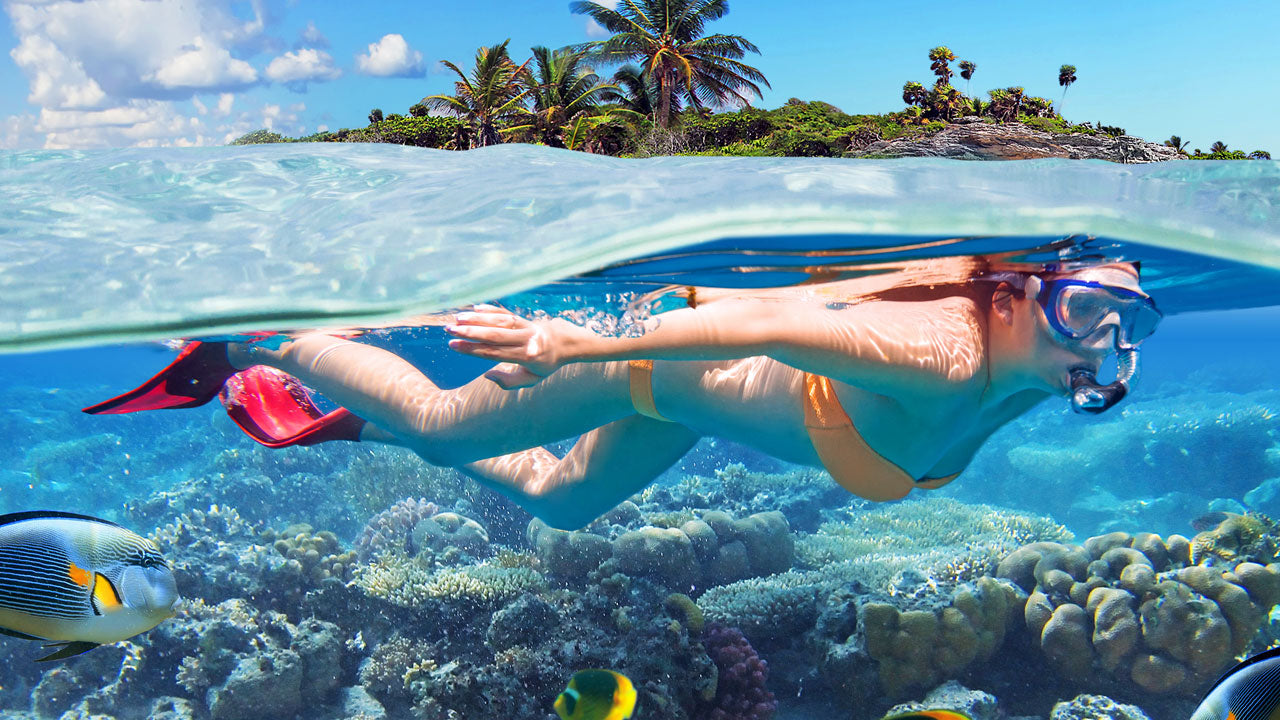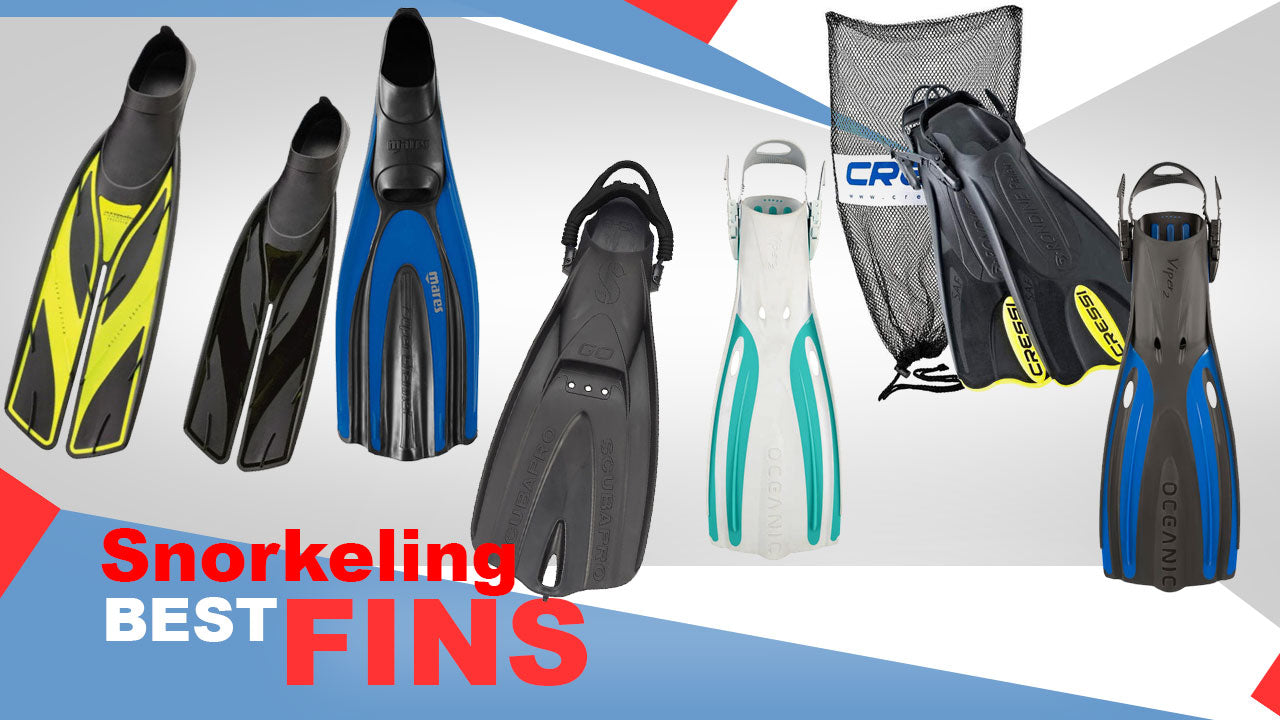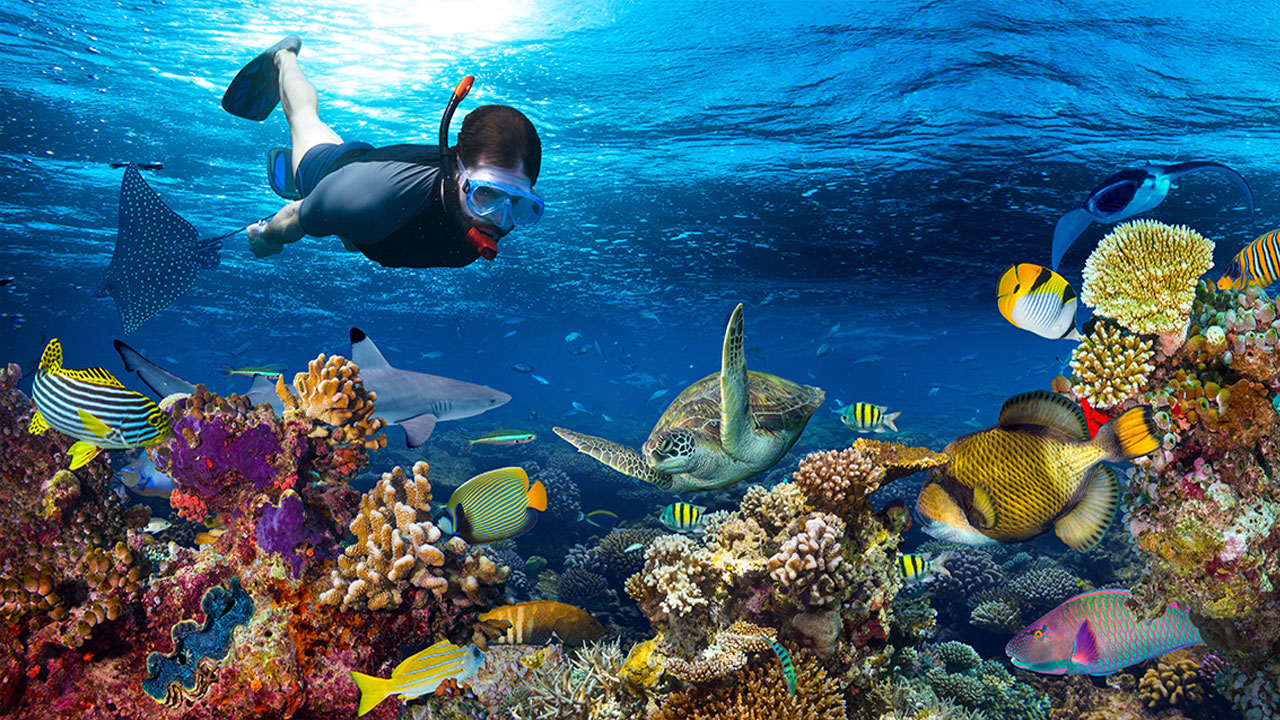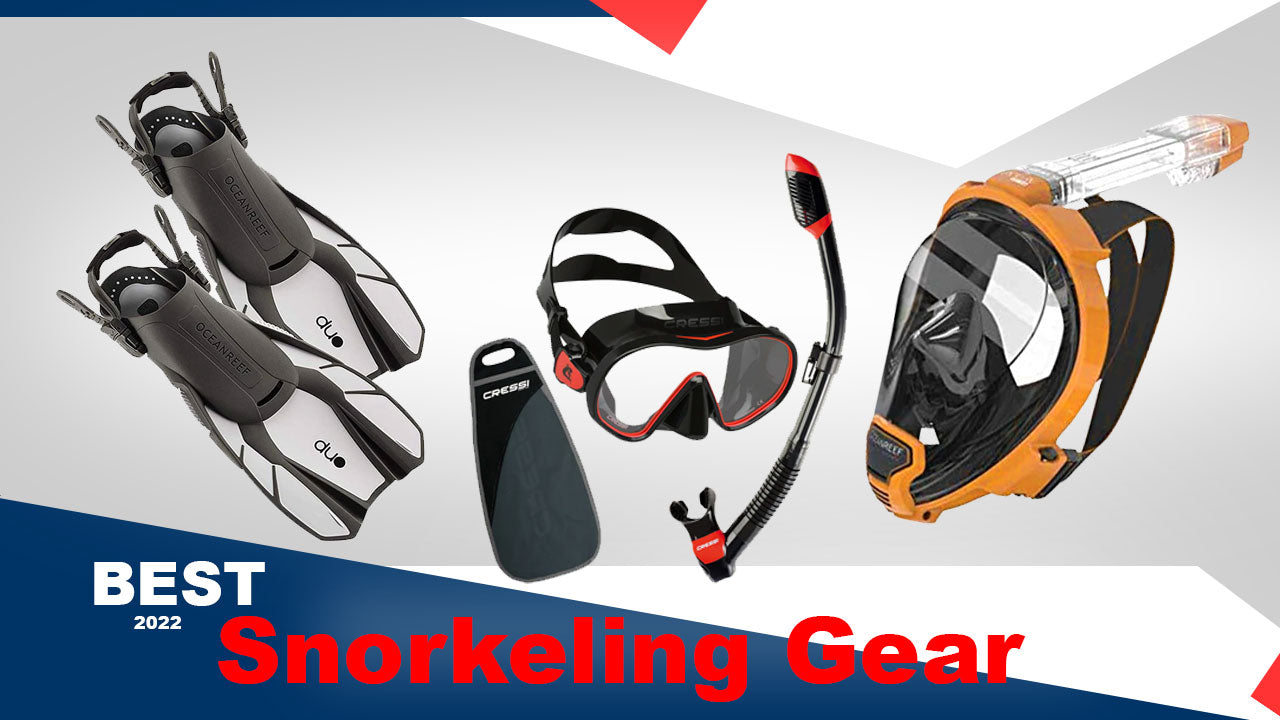Best Snorkeling Gear in 2024 - a Complete Guide
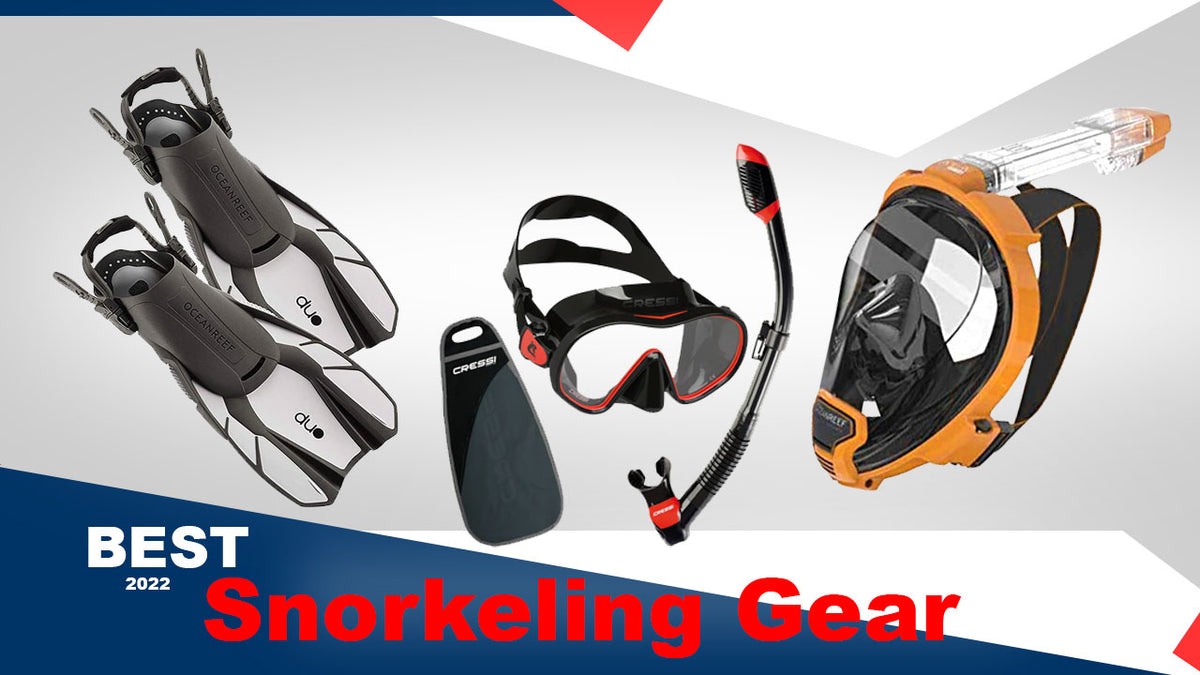
Snorkeling is considered an equipment-light activity, especially compared to scuba diving. The basic pieces of gear you should have are a mask (full-face or traditional), fins, and a snorkel. These can be sold either separately or as sets.
That being said, it is worth taking some time to research and select the best products for you and your family. Poor quality sets often sold in discount stores are likely to leave you disappointed. A mask that’s constantly leaking or fogging up, paired with uncomfortable fins and a flimsy snorkel can easily spoil the experience for you.
In this guide, we outline the basic features you should look for when selecting each piece of snorkeling gear, as well as provided our picks of top snorkeling sets, masks, snorkels, fins, and accessories for snorkelers.
Hopefully, it will help you choose the right equipment to enjoy your day on the water!
Table of Contents
- Top Snorkeling Gear Sets
- Top Snorkeling Masks
- Top Full-Face Snorkeling Masks
- Top Snorkels
- Top Fins for Snorkeling
- Top Snorkeling Accessories
- What to Look for Buying Snorkel Gear
- How to Use and Maintain Snorkeling Gear
Top Snorkeling Gear Sets
If you don’t want to buy each piece of snorkeling gear individually, you can go for a snorkeling set. Sets can include all three pieces (mask, snorkel and fins) or just a mask and snorkel, with fins being purchased separately.
One of the biggest reasons to purchase a set is value. Typically, buying a set is quite a bit less expensive than buying each piece of gear individually. In addition to good value, sets generally include gear that’s been specifically designed to go together, meaning the pieces will fit together seamlessly both in terms of style and function.
On the downside, sets tend to be more generic, one-size fits all sorts of solutions and will not be a good option if you are looking for something specific, like a mask fit or certain type of fins.
1️⃣ Cressi Duke Full-Face Mask and Bonete Fins
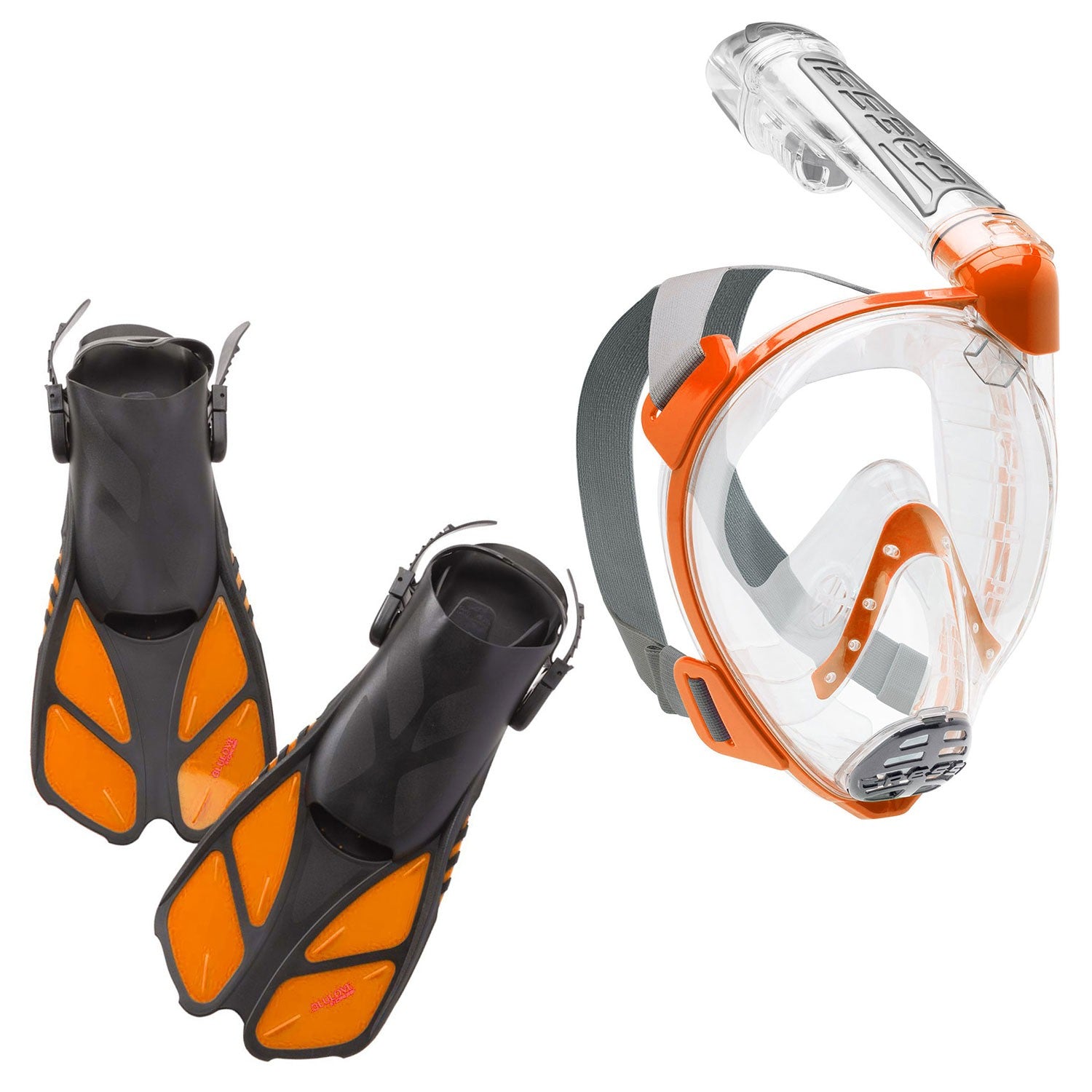

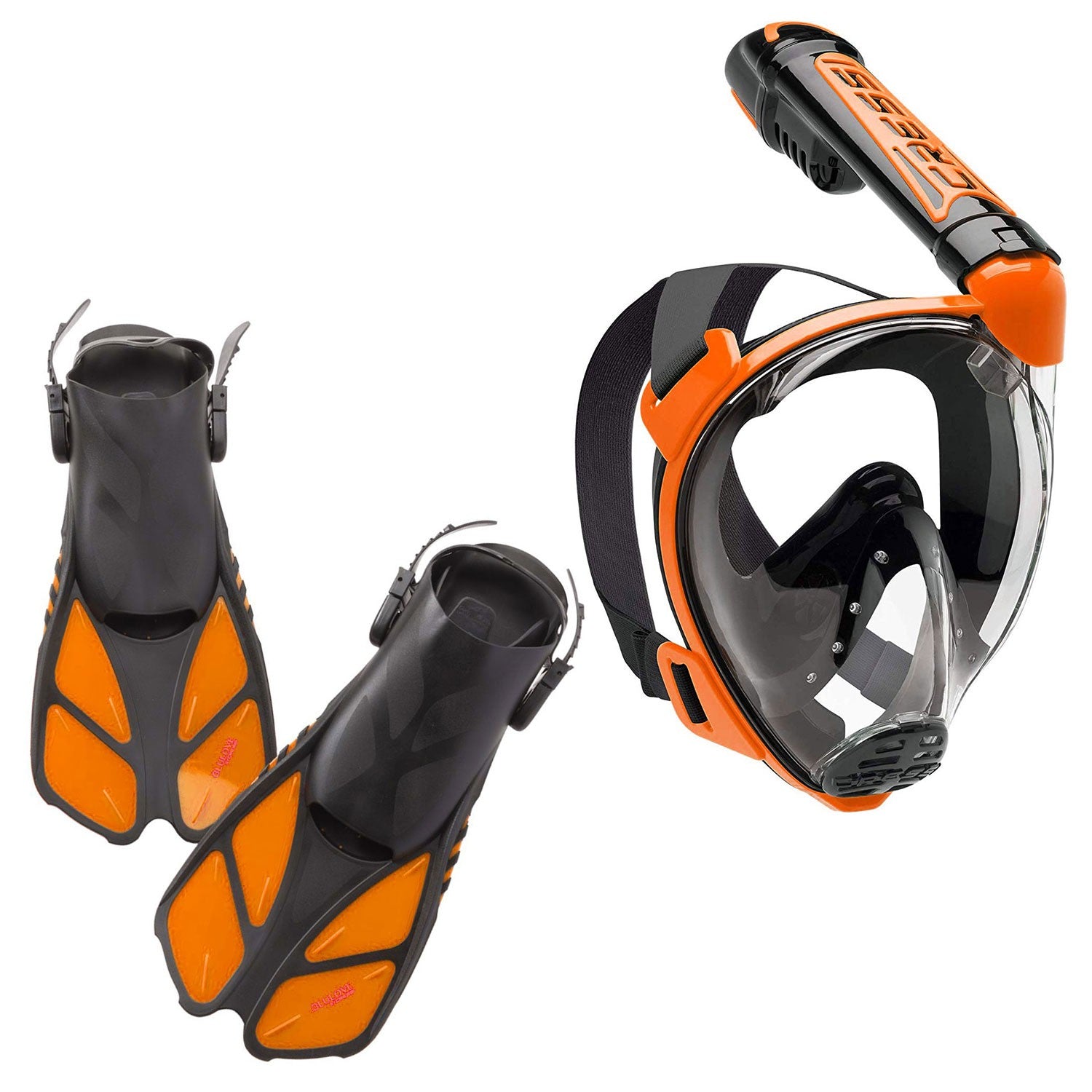
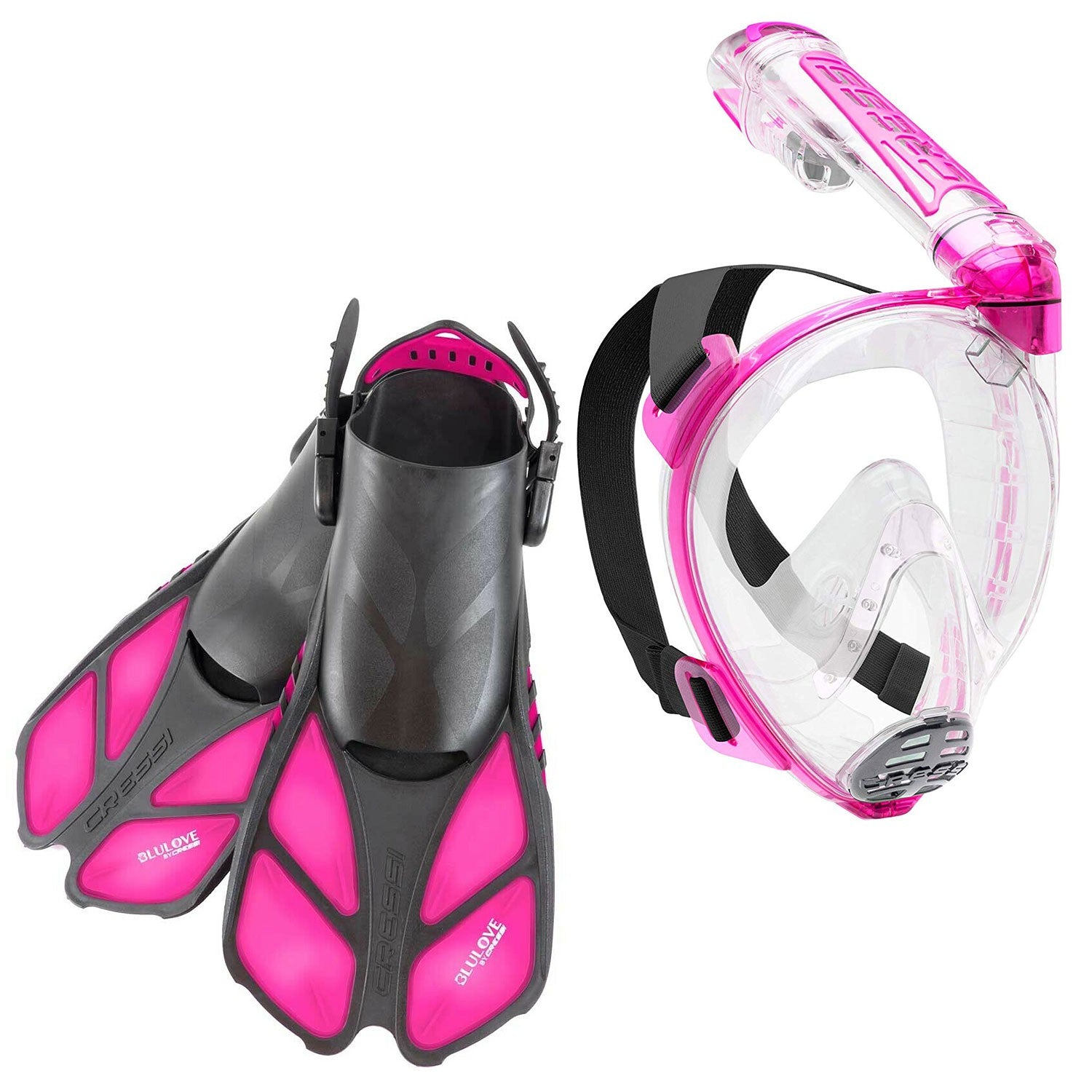
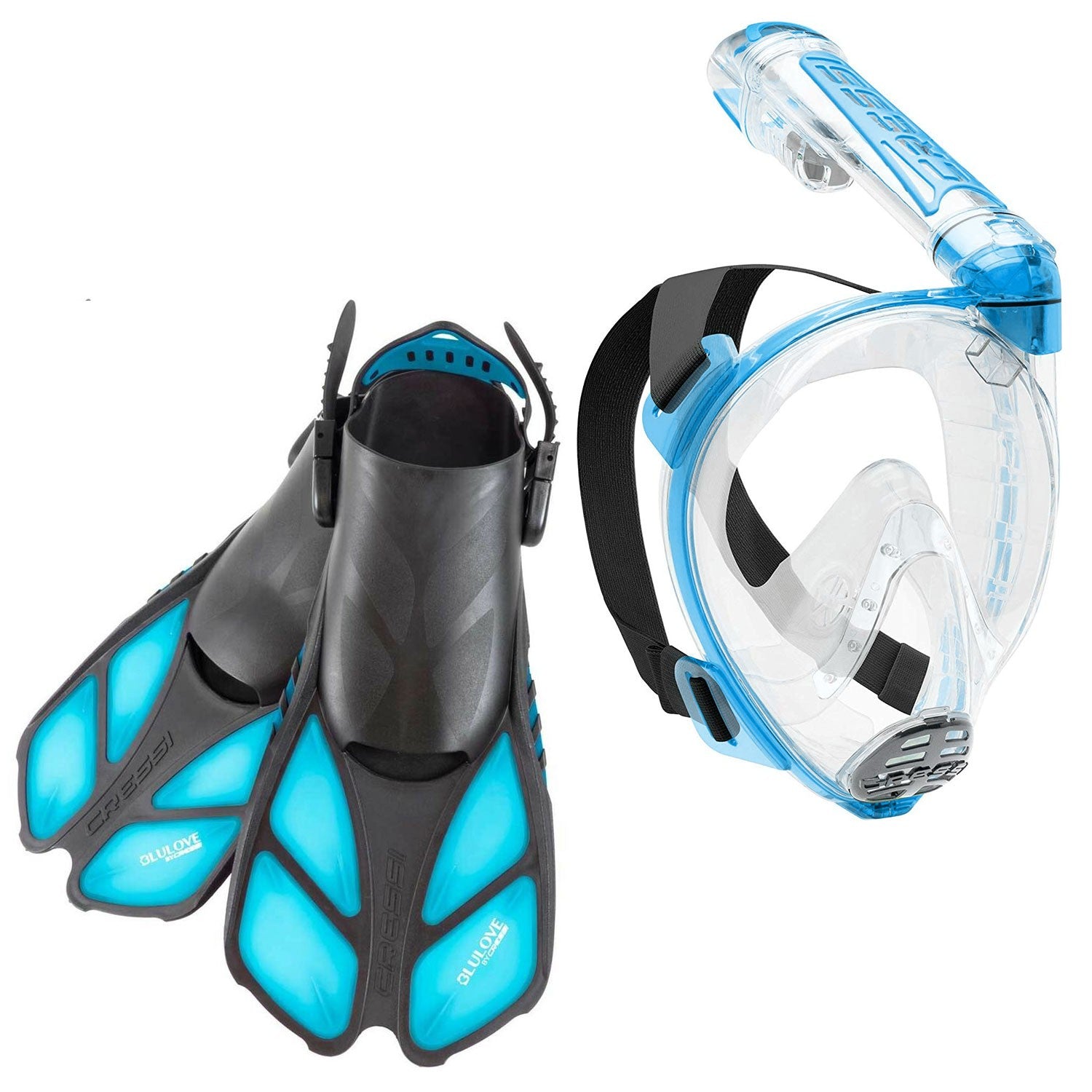
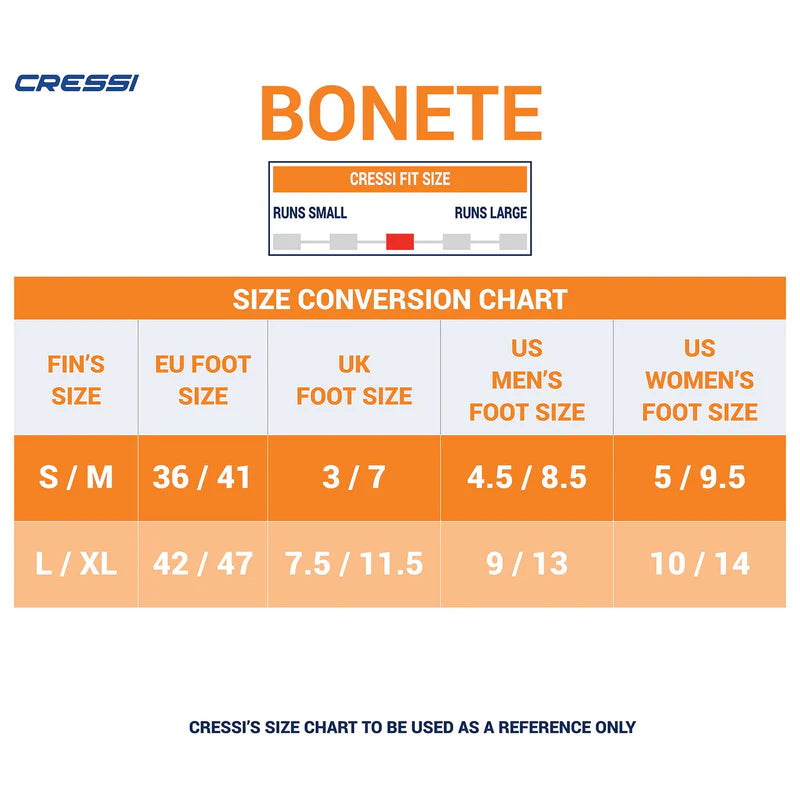
Best Set With an FFSM
- Full-face snorkeling mask (FFSM) with a wide breathing area
- Lateral tube position for airflow with minimal effort
- Short open heel fins ideal for travelers
- Practical net bag included
Cressi’s Duke full-face mask and short Bonete fins set is a great option for beginner snorkelers. The Duke is one of the most reliable full-face snorkeling masks on the market. Designed with safety in mind, it features a lateral air channel system that drastically eliminates any breathing effort thanks to a reduced airflow length circulation.
The dry snorkel keeps water out, while a specialized deflector eliminates fogging. The Bonete fins are ideal for travelers due to their compact dimensions and light weight. They also feature a composite blade design that provides comfortable finning and reduces cramping.
2️⃣ Cressi Bonete Pro Dry
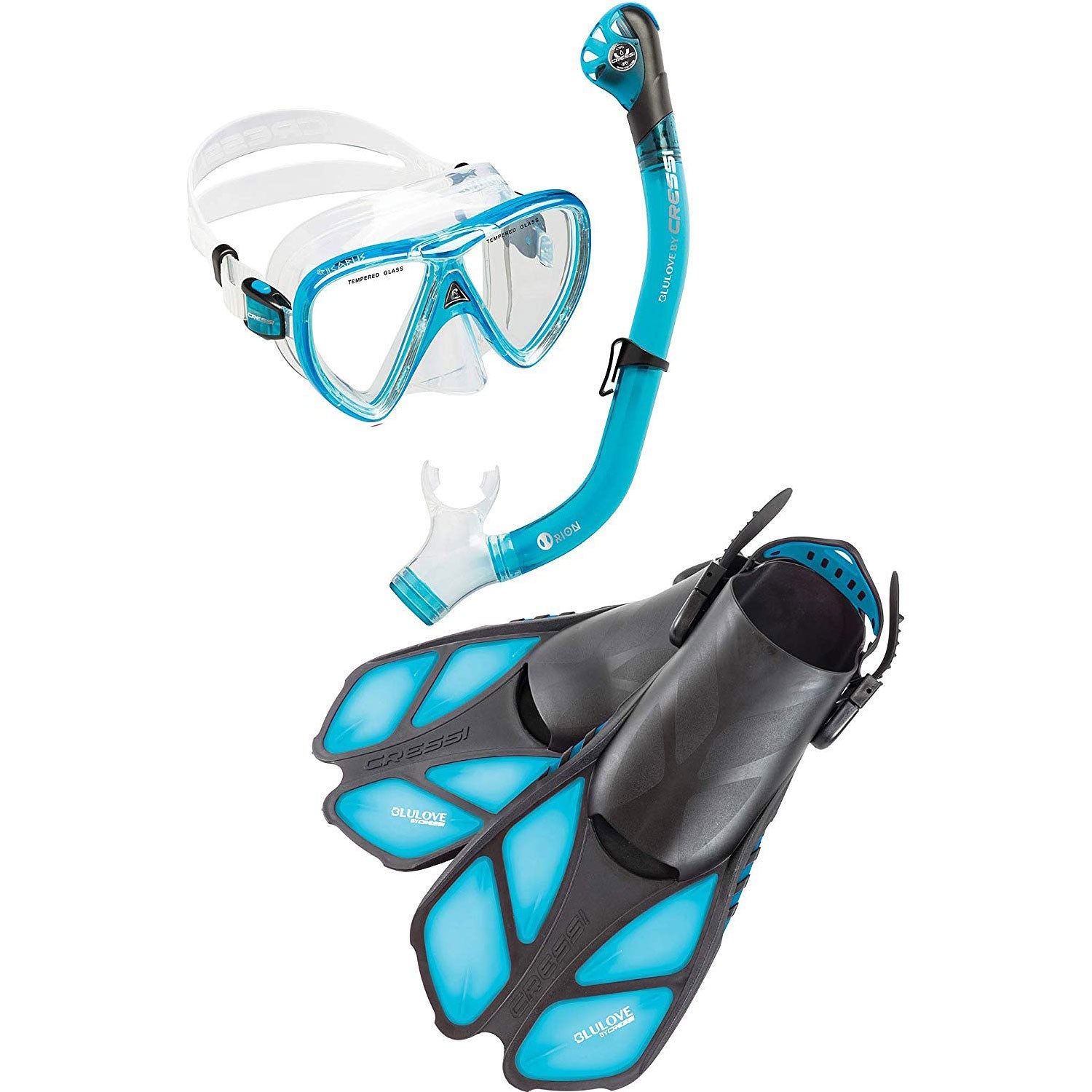

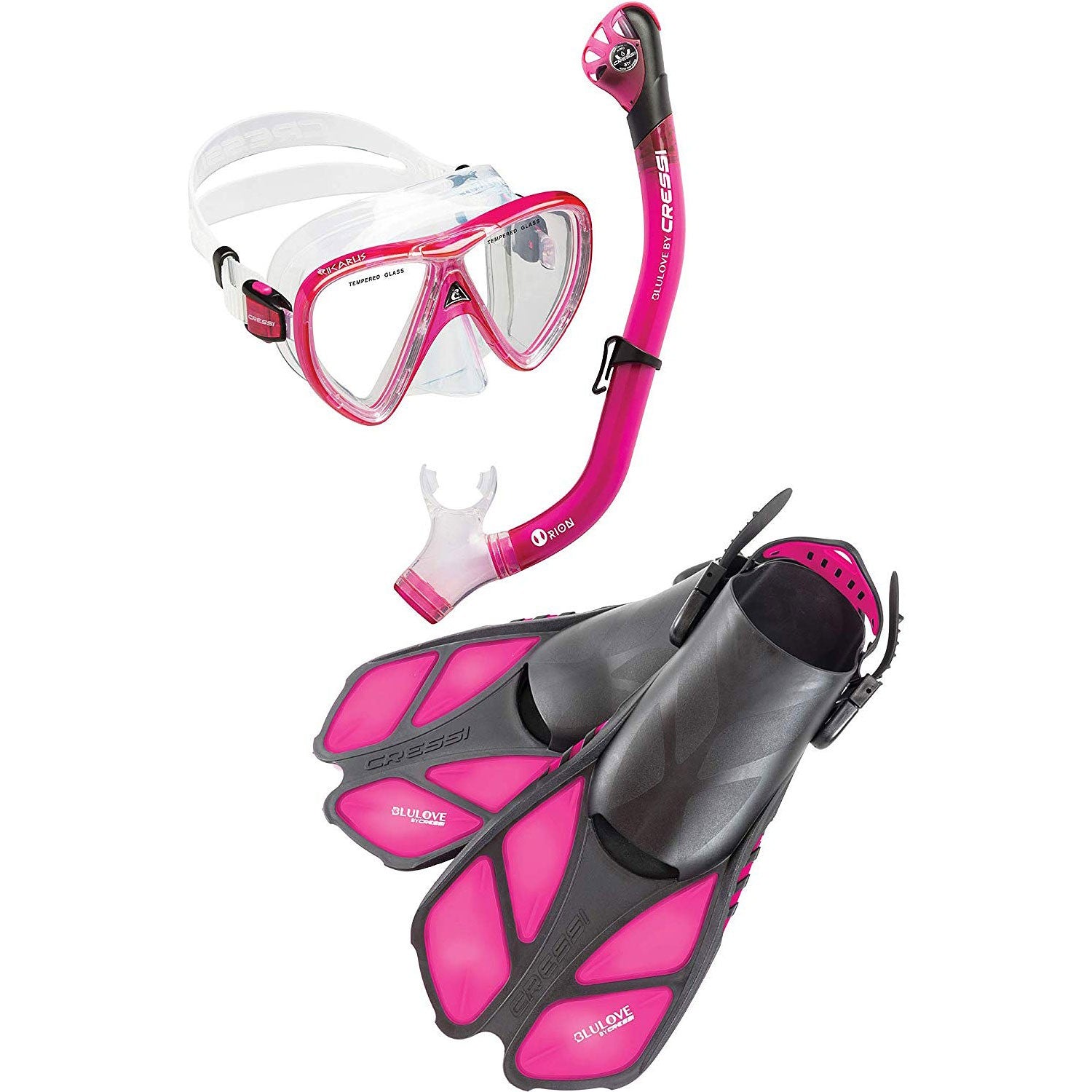
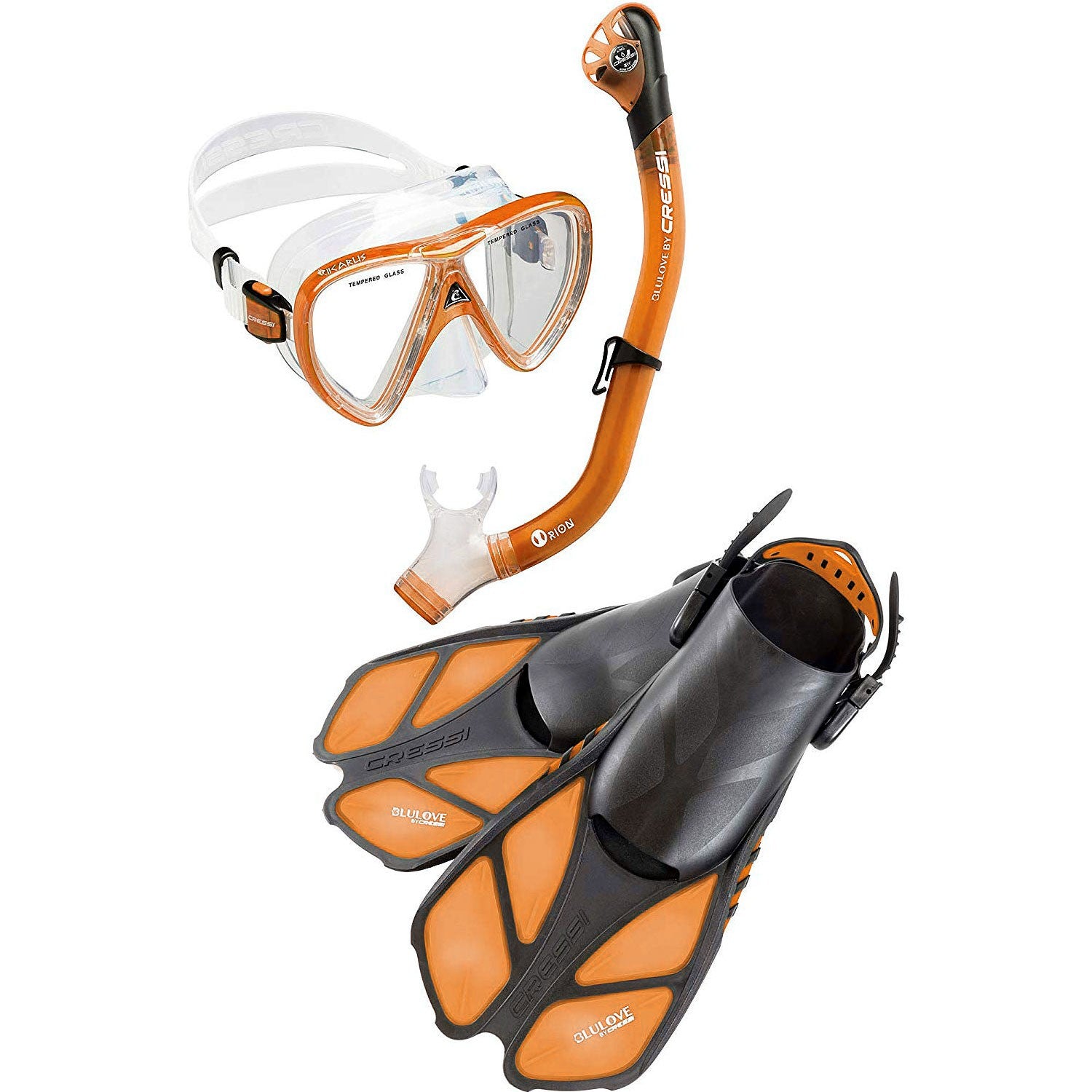
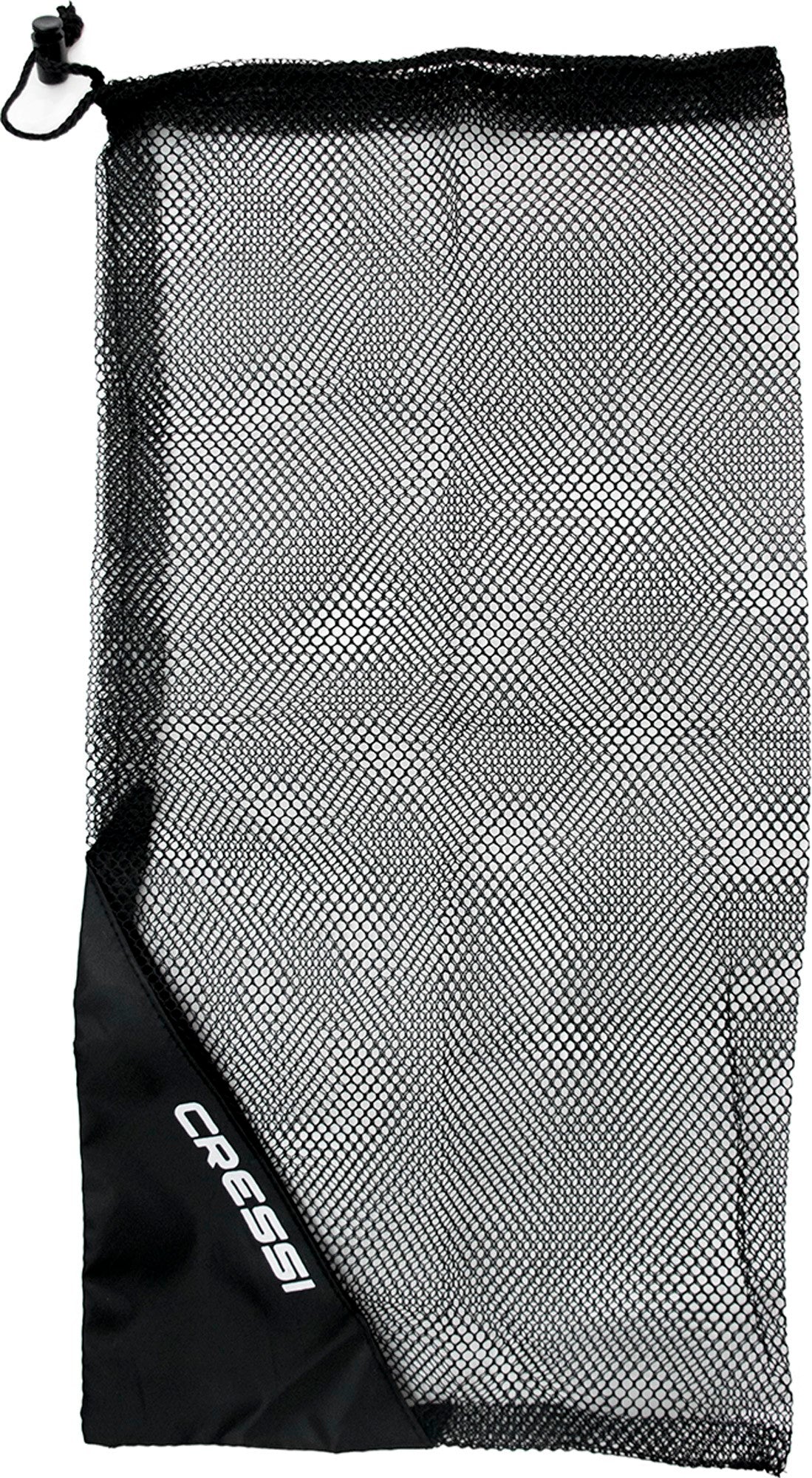
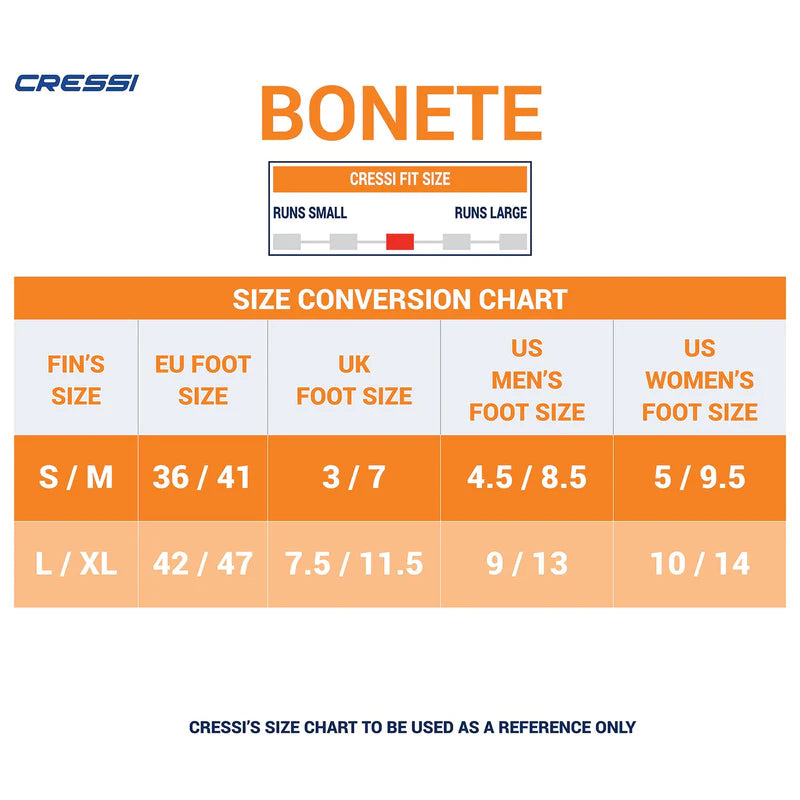
Best Set for Beginners
- Dry-top snorkel prevents any water from entering
- Durable mask with tempered glass lenses
- Very compact and lightweight short fins
- A mesh bag for easy transportation
The Bonete Dry Set is a great all-around snorkeling package for beginner snorkelers and avid travelers. The set comes in a mesh bag that makes it easy to carry, rinse, dry, and store after use.
The mask with the tempered glass lenses provides a clear vision. A dry-top snorkel protects you from water entering both from waves’ splashes and when submerged. Compact short fins provide relaxed finning with no cramps for extended periods.
Overall, this lightweight, practical and budget-friendly set can fulfill the needs of many snorkelers out there.
3️⃣ Mares Kids Sea Pals
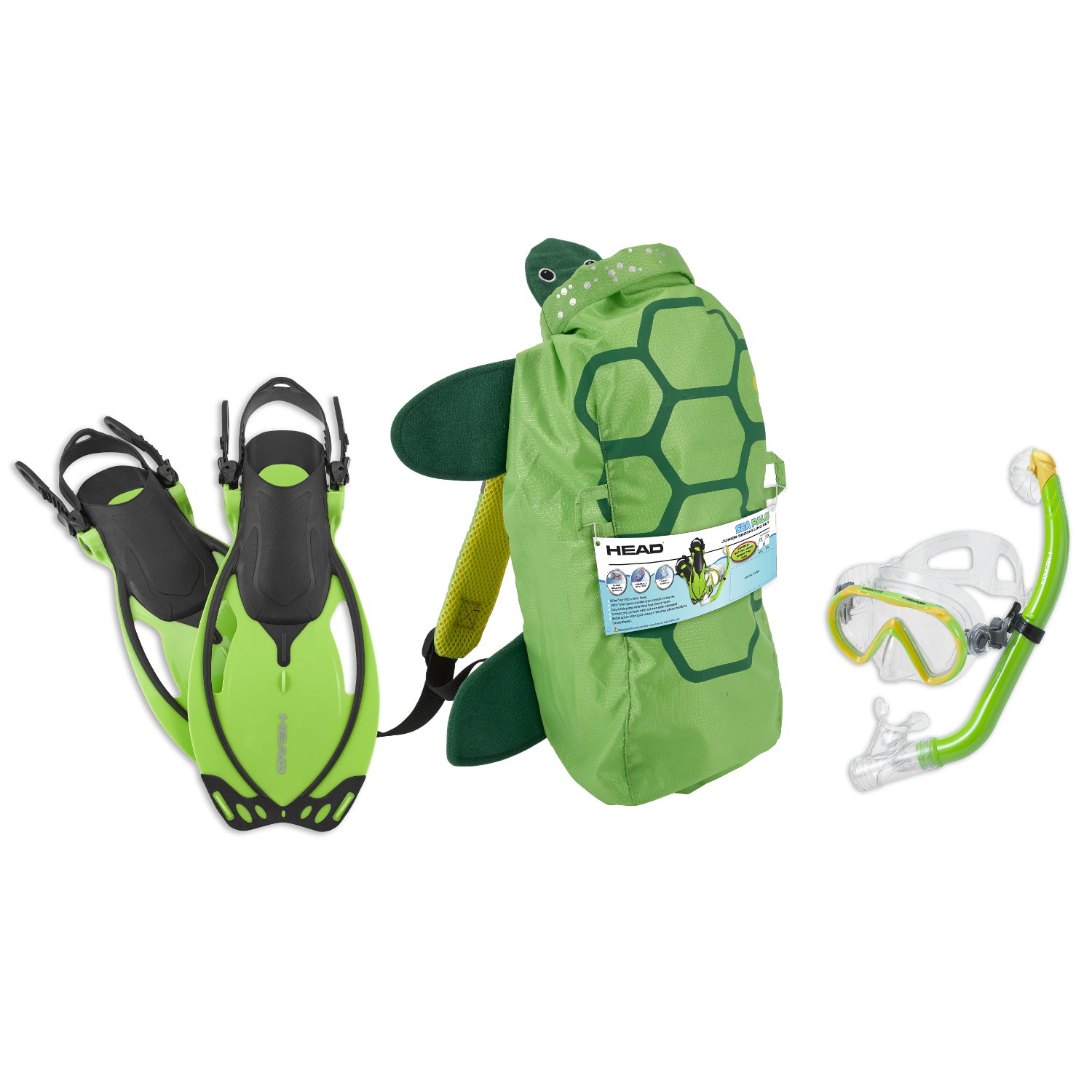

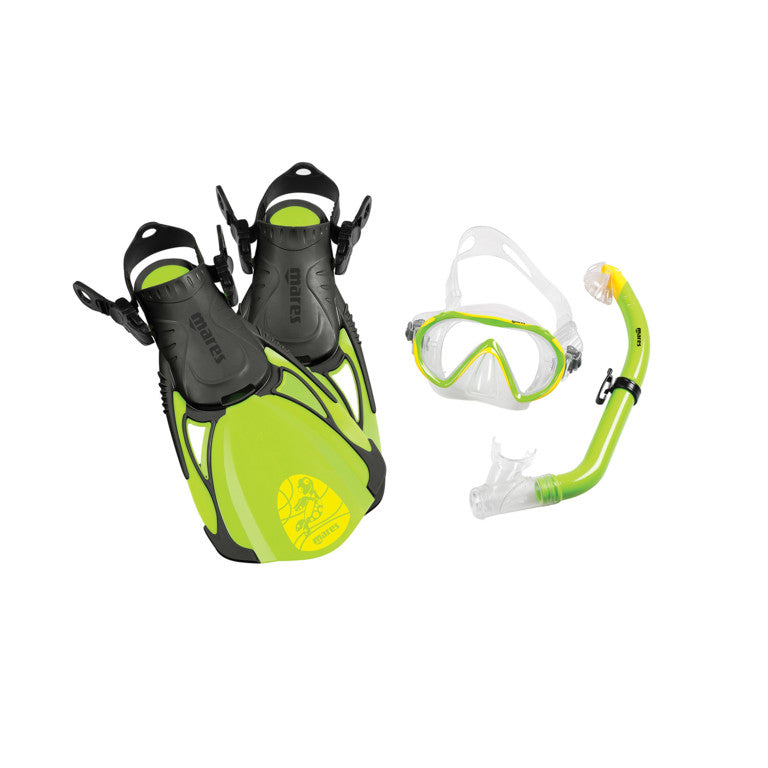
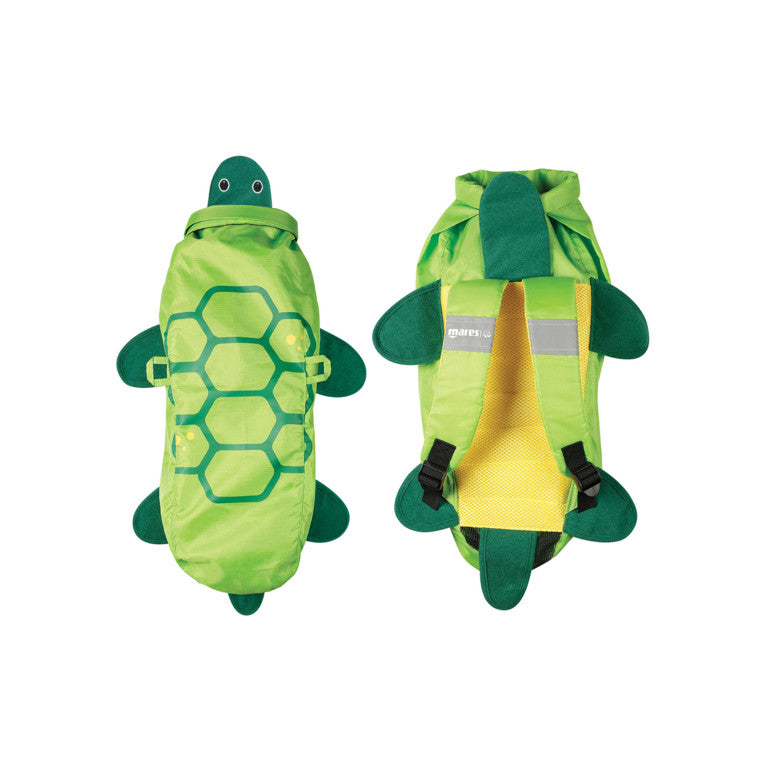
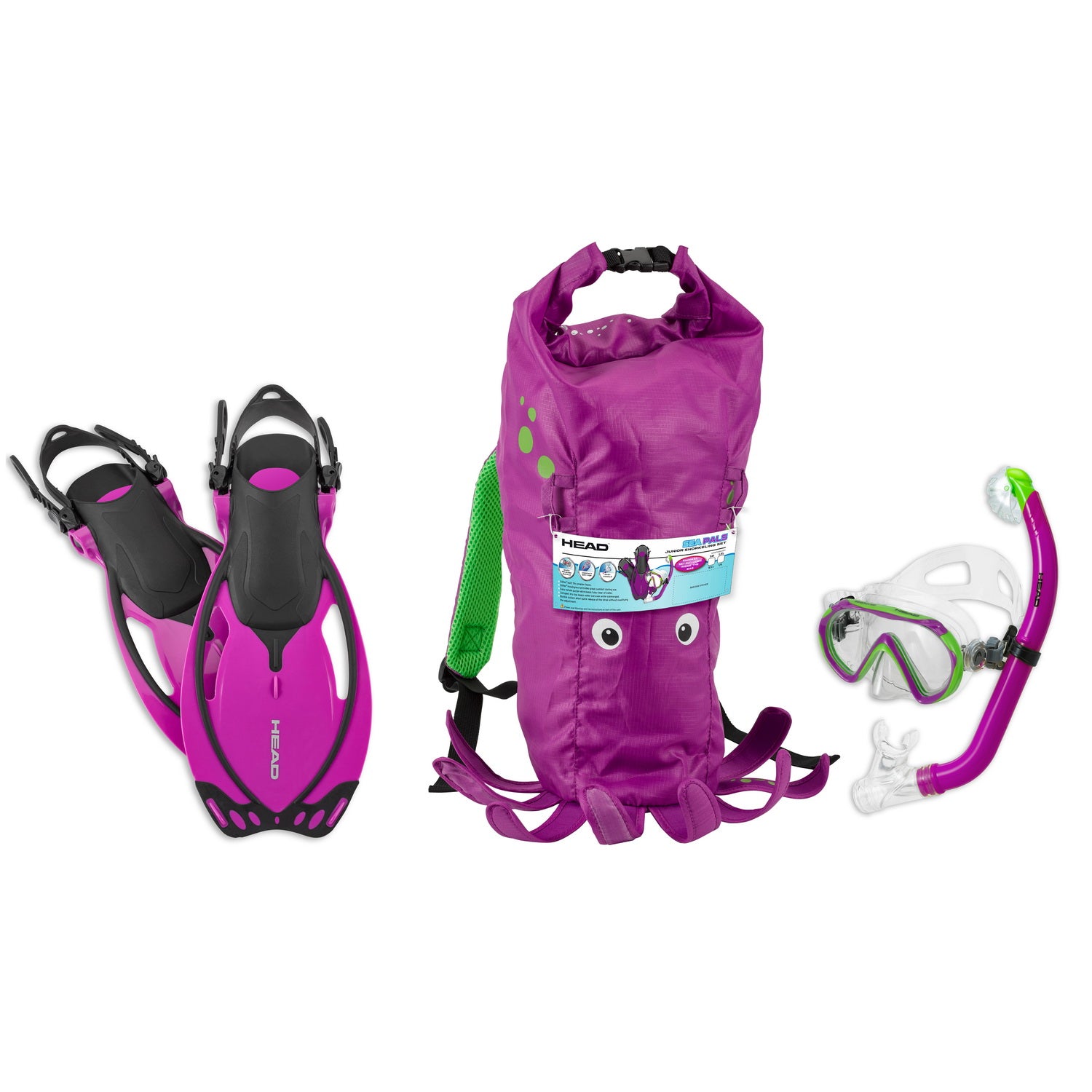
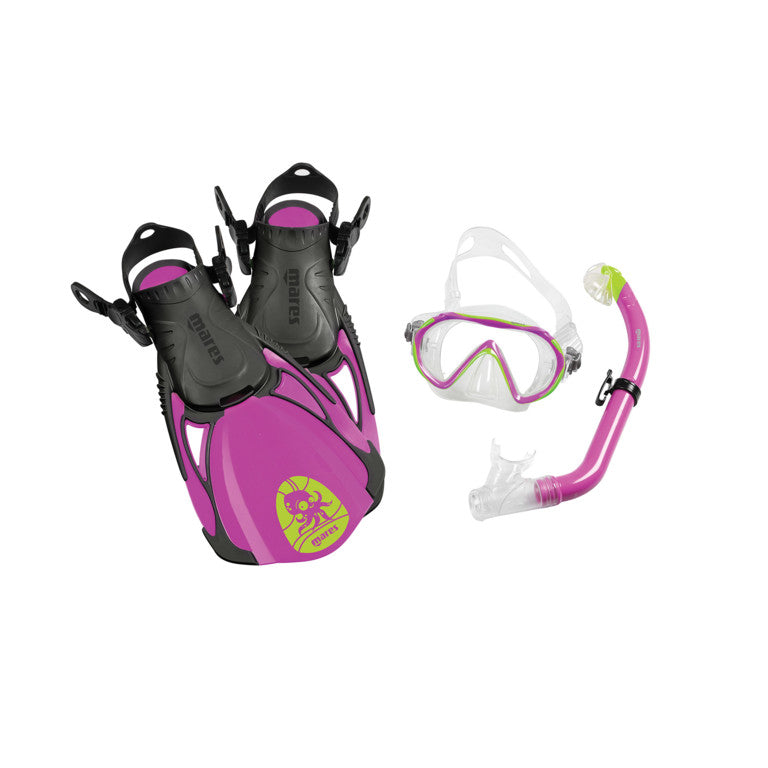
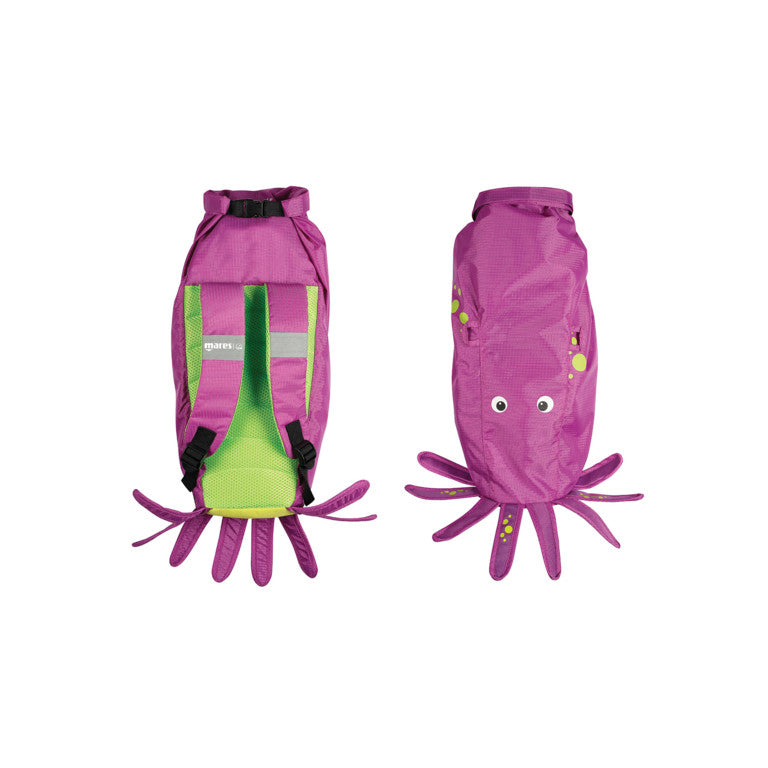
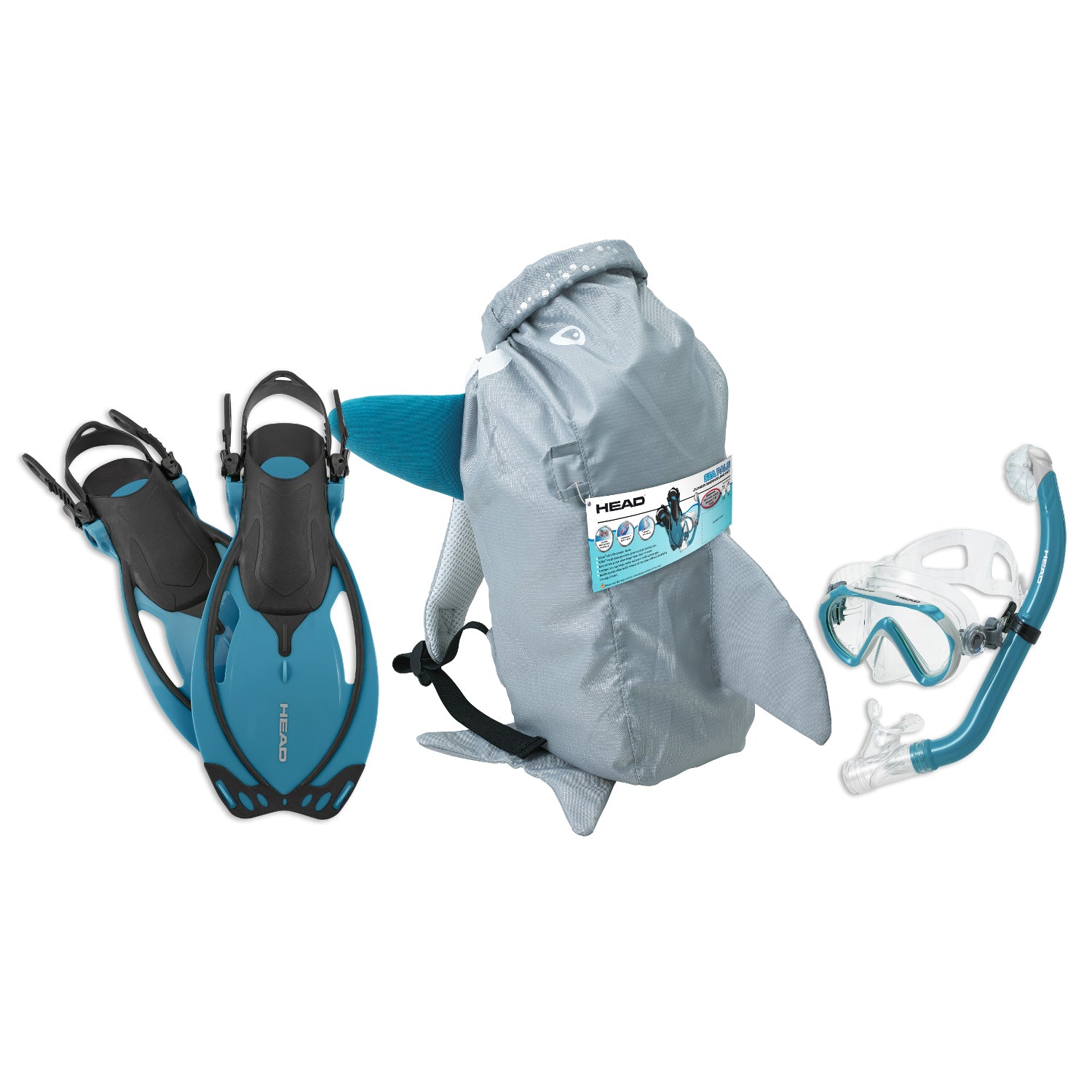
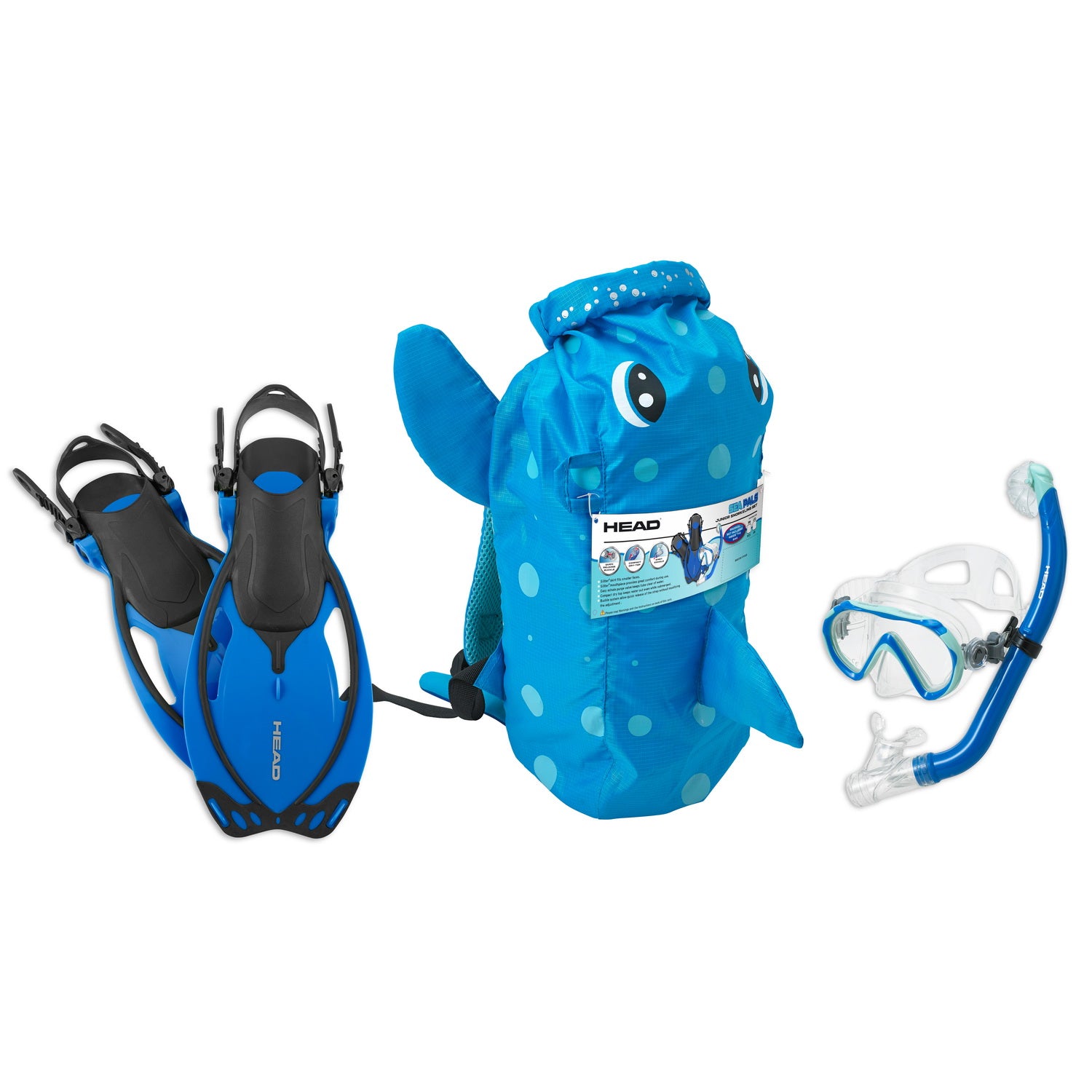
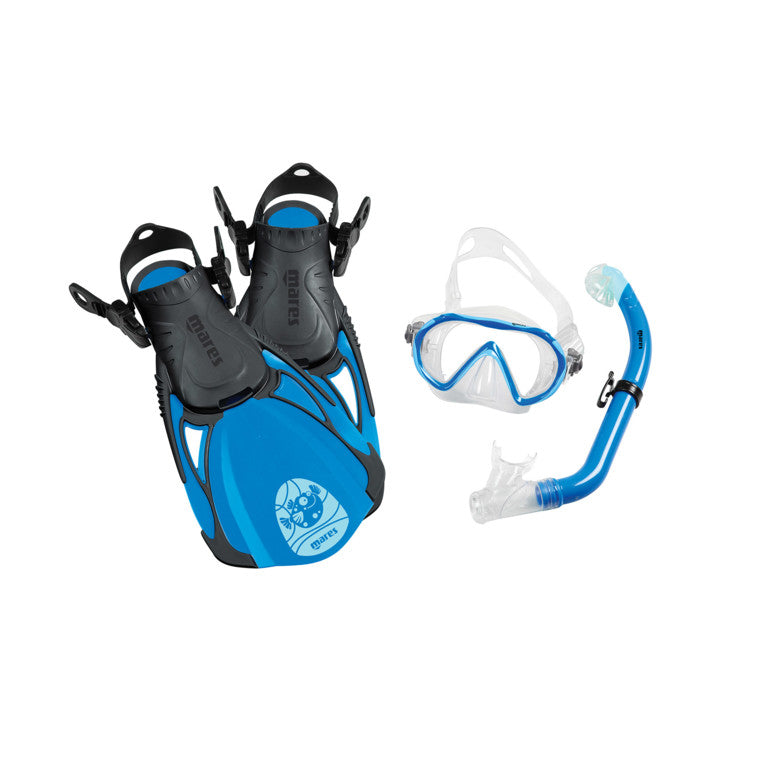
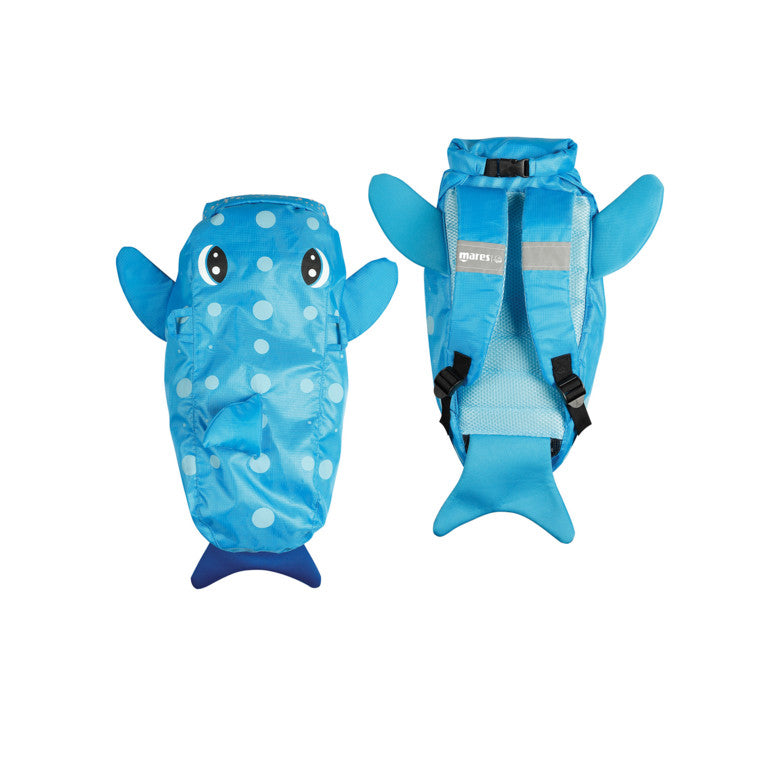
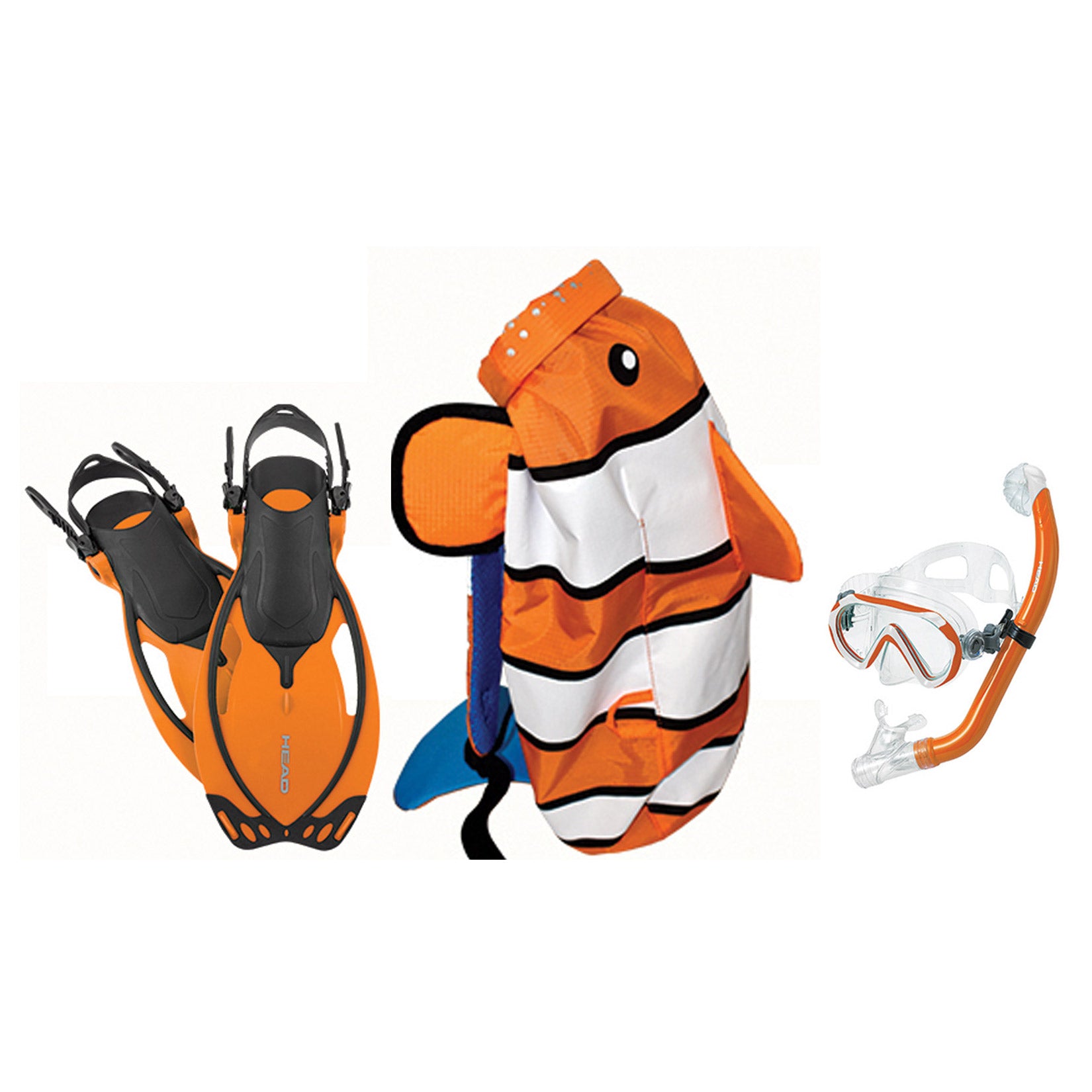
Best Set for Kids
- Snorkel with a dry top design and purge valve
- Adjustable fins with a quick release system
- Low-volume mask with a soft silicone skirt
- Fun character bag included
Mares Sea Pals Snorkeling Set is packed with features that will help to get your kid comfortable in the water. The mask has a smaller volume, perfect for kids' faces. Its soft, flexible skirt molds to the face shape perfectly and ensures a good seal.
The dry-top snorkel ensures the water will not get in, even when submerged, while the exhale tube makes purging and clearing simple. The open heel fins are adjustable and can fit multiple sizes to accomodate for growing feet.
This set is designed to help kids enjoy their first snorkeling experience with maximum fun and safety.
Top Snorkeling Masks
A quality traditional snorkeling mask is a versatile and reliable piece of gear that can accompany you for a variety of watersports including snorkeling, skin diving, freediving, scuba diving, or spearfishing.
Here are our top three picks of traditional snorkeling masks.
1️⃣ Cressi Focus
Cressi is a reputable and dependable brand when it comes to scuba and snorkeling gear.
The Cressi Focus is the traditional battle horse of the Cressi range and one of the most popular masks in the world. This light and compact two-lens mask will be perfect for traveling as it weighs only 175 g (0.4 lb).
The Focus has a soft silicone skirt available in transparent or black version, complete with a seal ring that provides an excellent fit and a high level of comfort even with prolonged use. The strap buckles are revolving for instant adjustment.
This multipurpose mask has minimum eye-lens distance (reduced internal volume), which makes the Focus perfect for all uses: snorkeling, scuba diving, skin diving, and freediving. The Cressi Focus is also available in the optic version: from -1 to -10 diopters with intervals of 0.5 diopters.
2️⃣ XS Scuba Oceanways SuperView-HD
XS Scuba Oceanways SuperView-HD has a SeeSharp High Definition Lens that provides the best view of the underwater. The black silicon skirt reduces the glare for an even better picture.
The Oceanways SuperView-HD filters out UV and bright glimmer by changing the white light harshness to a calming blue light for less eye strain. The mask comes in a plastic box with a lid.
3️⃣ XS Scuba Fusion
Top Full-Face Snorkeling Masks
If your snorkeling and water activities are on the surface only and you don’t plan to do any breath hold diving, then a full-face mask may be a good option for you. It has a number of advantages, including a more natural way of breathing using both nose and mouth, no jaw fatigue, great visibility, etc.
Learn more about the benefits & downsides of snorkeling with a full-face mask in the article below
1️⃣ Seac Libera
The Seac Libera has completely separate circuits for fresh air and exhaled air, which means you will not breathe in the same air you’ve just exhaled. Exhaled air is expelled through a SEAC patented exhaust circuit.
This full-face mask also features an anti-fogging system by the continuous flow of incoming air. Its one-way valves have a slightly larger cross-section that provides an effortless exhalation and effective expulsion of residual CO2.
A large anatomical hypoallergenic liquid silicone skirt with a shape designed to adapt to every kind of facial contour ensures the very best seal, safety, and comfort. The Seac Libera mask has a silicone strap with a co-molded colored insert for perfect fixation on the head.
What’s more, there are two ways to adjust the strap, both in front and in the lower section. And quick-release buckles can release it instantly for maximum safety.
2️⃣ Cressi Duke
Cressi separated the breathing chamber from the vision chamber, which gives users multiple benefits: to breathe freely, expel CO2 build-up, and not fog up the vision chamber.
All those benefits are possible because of Cressi Duke’s unique design feature, which is a lateral tube position. This advantage is enhanced by the fact that neither the breathing chamber nor the tube has any valves to impede a user’s breath.
What’s more, the extraction chamber has an enlarged volume in order to allow for optimal CO2 extraction.
3️⃣ Ocean Reef ARIA QR+
Ocean Reef Aria QR+ full-face snorkeling mask provides 180-degree vision with no fog obstruction thanks to a well-structured and fully tested one-way air circulation system.
The mask is compatible with a range of accessories like:
Optical Lens Kit,
Snorkie Talkie,
Surface Unit for Snorkie Talkie, etc.
What makes this mask perfect is that all seals are made from black silicone, which reduces incoming surface glare for a more enjoyable visual experience. For your extra comfort during transportation and after use, Ocean Reef Aria QR+ comes with a reusable carry bag with a mesh bottom.
Top Snorkel Recommendations
We gathered the best three snorkels of every type (dry, semi-dry, and classic) to provide you with the best experience when using each one of them.
1️⃣ Cressi Supernova
The Cressi Supernova is manufactured from prime quality materials, which makes it safe and comfortable to use.
The dry top and splash guard ensure double protection against water entering the tube both when submerged and on the surface. In case some water does get in, you will be able to clear it easily thanks to the elliptic purge valve.
The mouthpiece is 100% hypoallergenic and has a convenient angled shape that prevents jaw fatigue. The Cressi Supernova snorkel is very lightweight, flexible, and easy to pack.
You can choose from a variety of color options and even purchase the kids version of Supernova Dry snorkel in a set with mask and fins.
2️⃣ Oceanic Ultra SD
The Ultra SD (Semi-Dry) employs a patent pending deflector to stay dry in waves and wind. The water will get in when the snorkel is submerged, so the Ultra SD incorporates an oversized purge valve that will make clearing a breeze.
The Oceanic Ultra SD is designed with a flexible tube part near the bottom so you can easily drop the mouthpiece away when not needed.
This semi-dry snorkel is very durable.
Additionally, the Oceanic Ultra SD has a replaceable liquid silicone mouthpiece so you can change it to prolong the snorkel’s life.
3️⃣ ScubaPro Apnea
ScubaPro's Apnea easily attaches to your mask strap when being used. When not needed, it can be folded and stowed in an accessory pocket and when it's time to do some surface swimming, it pops right back into shape.
The traditional J-tube design is simple and reliable. Apnea is made from soft and flexible non-toxic silicone. The upper barrel can be removed for snorkelers who prefer a shorter pipe.
This snorkel is extremely lightweight, only 0.1134 kg (0.25 lb), which is perfect for traveling. Without question, this is a versatile and easy-to-use surface breather.
Top Fins for Snorkeling
Fins are not mandatory for swimming; however, they are necessary for snorkeling, especially if done in rough seas. Fins are your support when moving in water, allowing for enough speed and power without too much effort.
Snorkeling fins should be lightweight and quite soft for you to be used comfortably without socks or boots.
For this list, we picked three rather different types of fins, with the only common feature - they all will provide you with the best snorkeling experience.
To see our full selection of best snorkeling fins, check out this article
7 Best Snorkeling Fins 20221️⃣ Mares Avanti Superchannel Full Foot Fins
The Avanti Superchannel by Mares are among the best full foot fins on the market. The special Channel Thrust blade with a very flexible center area and two side channels mimics the split fin motion and moves a much greater amount of water compared to other fins of the same size. The result is greater thrusting power with the same amount of effort.
The orthopedic foot pocket with variable thicknesses provides superior comfort.
Last but not least, the compact size and light weight of the fin make it an ideal option for travel and snorkeling in warm water.
All in all, Mares Avanti Superchannel are time-tested, powerful, yet not too stiff, versatile fins that can be comfortably used by beginners and advanced snorkelers alike.
2️⃣ Cressi Palau Short Fins
3️⃣ ScubaPro Go Fins
Top Snorkeling Accessories
Exposure Protection for Snorkelers
For many snorkelers, visiting tropical destinations, “exposure protection” may simply be swimwear and lots of Reef Safe Sunscreen.
However, to ensure the best protection against sunburn, as well as prevent scrapes and stings, we suggest you cover your skin by wearing a rash guard with a high UPF rating. It will effectively block the harmful radiation and even provide a bit of warmth for extended snorkeling trips.
As for the rashguard style, there are a variety of options you can choose from - short-sleeved, sleeveless or full-sleeved tops, shorts, pants, and even full-body suits. You can go for any style you like, but remember, the areas most susceptible to sunburn during snorkeling are your neck, shoulders, waist, and calves, so it’s best to have them covered.
For cooler waters, you will want to get a neoprene wetsuit (either a shorty or a full-length) to keep you warm.
Snorkeling vest
A snorkeling vest is a great tool for beginners and more experienced snorkelers alike. It will help new snorkelers feel more confident in the water, and allow seasoned snorkelers to take it easy and reduce fatigue during long snorkeling trips.
Pro Tip! What’s more, in many places around the world local laws require snorkelers to wear a vest, so check if it’s the case in the destination you are planning to visit.
For more info on Personal Flotation Devices, check out our article Life Jacket vs. Snorkeling Vest - Different Types of PFDs
Knife
Entanglement is typically not a big risk during snorkeling but if you are visiting areas where sea kelp or old fishing nets can pose a hazard, having some sort of a cutting tool is a good idea.
Pro Tip! Choose a small knife that can be attached on your lower leg or go for a line cutter.
Snorkeling bag
A well-made snorkeling bag (or - mesh bag) with padded backpack straps can really make your shoulders happier when walking or hiking to the snorkeling site.
A good sized mesh bag will hold all your snorkeling gear, keeping it organized and allowing it to dry.
Dry bag / box for valuables
It’s practical to take a dry bag with you on any water adventure, snorkeling included! A dry bag or a small waterproof box will seal to keep everything inside dry, no matter how wet your surroundings are.
See All Dry BagsWhat to Look for When Buying Your Snorkeling Gear
Struggling with picking the gear to suit you best?
Enjoy our list of the most important things to consider before purchasing any piece of your snorkeling equipment.
What to Look for in a Snorkeling Mask
1. Lens Quality and Visibility. Properly constructed masks will feature impact-resistant (tempered) glass lenses that can withstand pressure if you go for breath-hold dives. Lenses made of plastic tend to fog up and scratch easily, while those made of standard glass can even be hazardous.
The glass that has not been specially treated to increase its strength has the propensity to splinter into small shards when broken, which can damage the eyes in case of an accident.
2. High Grade Silicone Skirt. The mask skirt should always be made from high grade silicone for the best level of comfort and superior sealing. Silica or other plastic based skirts are not as flexible, comfortable to use and may even cause face rashes.
Another feature that can be found on all good mask skirts is a secondary skirt. The secondary skirt increases the surface that is able to seal against the skin and significantly reduces the possibility of a leak.
3. Comfortable Head Strap and Quick-Adjust Buckles. A mask strap should snugly fit against the head’s natural curvature and should also be easy to adjust. Look for a buckle system that allows some range of motion for strap positioning and preferably has a single-button release mechanism.
Things to Consider When Choosing a Snorkel
1. Snorkel Top Type. There are three different snorkel top types - classic, semi-dry and dry. Determine which one suits you best, depending on your skill level and needs:
◘ Classic snorkels have a full opening at the top. It allows for an unrestricted flow of air in and out of the snorkel but the water can splash in. This system is best for snorkelers with confident airway control who want a light snorkel with no extra bulk.
◘ A semi-dry snorkel is partly closed at the top due to a wave deflector which works to direct water that splashes away from the snorkel opening. With this type of snorkel water will still get in if you submerge, so it is also a good option for those more confident in the water.
◘ Dry-top snorkels have a wave deflector to push splashed water away from the snorkel too, but also feature an opening valve with a float mechanism that closes when you go below the surface, preventing water from entering the snorkel all the time it is underwater. This type of snorkel is a good option for snorkelers of all skill levels but is especially useful for novices to help them feel more comfortable in the water.
2. Purge Valve. Purge valves and water collection chambers help to drain water away from your mouth and make clearing the snorkel easier by eliminating the need to exhale sharply to push the water up the snorkel tube. The size and shape of purge chambers can vary but the principle is the same.
3. 100% Pure High Grade Silicone Mouthpiece. Many cheap snorkels use silita or PVC as a silicone-like material in key components such as the mouthpiece. This is a bad option because such mouthpieces are hard, uncomfortable to use and tend to lose shape quickly. They are also likely to rub and cause soreness.
Silicone doesn’t have these problems and is a comfortable, soft and flexible material. Silicone mouthpieces are much less likely to rub or cause irritation even after prolonged use. Many reliable manufacturers round off the edges or even create custom mouthpiece profiles to achieve the best comfort level possible.
Choosing Fins for Snorkeling
1. Foot Pocket Style. Snorkeling fins can be a full foot, open heel, or a hybrid - barefoot open heel design.
◘ A full-foot design is suitable for those who usually snorkel in warm water and don’t need to wear boots underneath. Full foot fins are lightweight, easy to slip on, spare space in the luggage, and provide you with great efficiency. However, when it comes to sizing, it is important to find a good fit, as the fins that are even slightly too large or too small can cause a lot of discomfort.
◘ If you will be snorkeling in cold water, where you’ll need to wear booties, an open-heel fin is a better choice. Another reason to consider this type of fin is for water entrances that are rocky or full of urchins. You can walk out in your boots and then just put your fins on over them. An added benefit of having an adjustable heel strap is that the size range for a particular pair will be more generous than with the full foot style.
◘ There is also a third option, which combines the attributes of full-foot and open-heel fins. This hybrid design features a bungee strap, just like in open-heel fins, but the foot pocket is softer, smaller, and more comfortable, making it possible to wear these fins with bare feet. So, if you are looking for a compact, travel-friendly fin with more size adjustability, open-heel barefoot fins may be a good alternative for you.
2. Blade Size and Stiffness. As a general rule, fins for snorkeling should be flexible and light. As for the blade length, shorter fins are typically the best option for snorkelers. They make it easier to move around on the surface and sit nicely in a suitcase.
How to Use and Maintain Your Snorkeling Gear
Wish to have the best experience while using your gear and want to know how to prolong its life for as long as possible?
Here are the top tips to help you do so.
- Before heading out to the beach, consider testing your gear in a local pool. This will help you get used to your new snorkeling set, discover any possible malfunctions, and learn some basic snorkeling skills if it is your first time.
- Your new snorkeling mask will probably fog up for the first time. So do not neglect preparing it beforehand. The most common way is to use an anti-abrasive toothpaste, rinse the mask in fresh water, apply an anti-fog solution afterward, and rinse again. This way, your brand-new snorkeling mask will provide you with the best views ever.
- It is vital to use the correct anti-fog. There are differences between the solution for plastic goggles and glass lenses. Make sure you purchase the right one. If you are in a rush to get into the water, saliva is always a great alternative.
- Your perfect snorkeling gear should be comfy. While the equipment initially may be slightly unusual, it should not hinder your movement, chafe, or squeeze. So try not to tighten up the straps too much.
- Always rinse your gear in fresh water after use. (NOTE!) Saltwater and sand are a very destructive combo for any equipment.
- Avoid direct sunlight when drying it up. After rinsing the gear consider hanging it up to dry in a warm ventilated space with no access to the sun.
- Stock and transport your snorkeling gear in a mesh bag to avoid any scratches or losing some parts from a set on your way. It is a great idea to purchase one if your set does not come with it.

